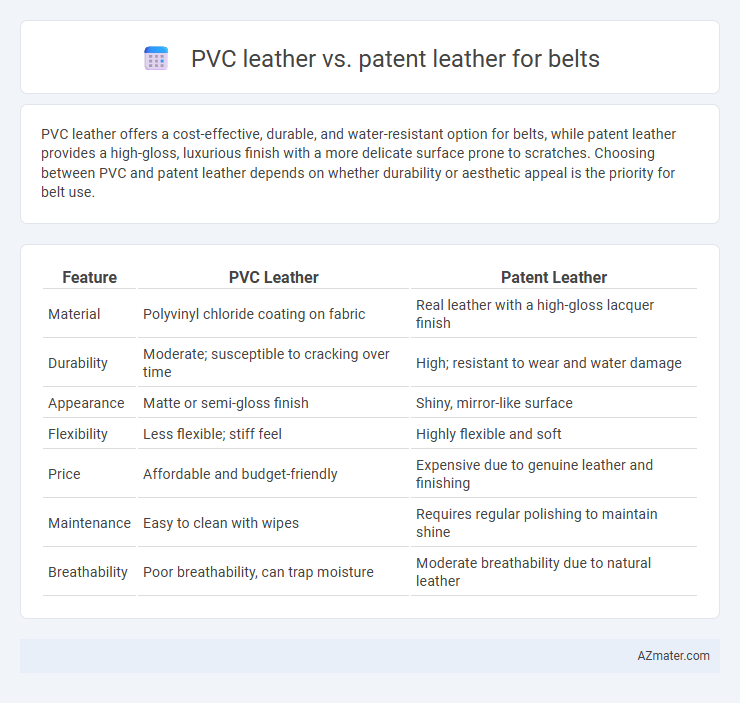PVC leather offers a cost-effective, durable, and water-resistant option for belts, while patent leather provides a high-gloss, luxurious finish with a more delicate surface prone to scratches. Choosing between PVC and patent leather depends on whether durability or aesthetic appeal is the priority for belt use.
Table of Comparison
| Feature | PVC Leather | Patent Leather |
|---|---|---|
| Material | Polyvinyl chloride coating on fabric | Real leather with a high-gloss lacquer finish |
| Durability | Moderate; susceptible to cracking over time | High; resistant to wear and water damage |
| Appearance | Matte or semi-gloss finish | Shiny, mirror-like surface |
| Flexibility | Less flexible; stiff feel | Highly flexible and soft |
| Price | Affordable and budget-friendly | Expensive due to genuine leather and finishing |
| Maintenance | Easy to clean with wipes | Requires regular polishing to maintain shine |
| Breathability | Poor breathability, can trap moisture | Moderate breathability due to natural leather |
Introduction: Understanding PVC Leather and Patent Leather
PVC leather, a synthetic alternative made from polyvinyl chloride, offers durability, water resistance, and affordability, making it popular for belts requiring low maintenance. Patent leather, crafted from coated genuine leather with a high-gloss finish, provides a sleek, polished appearance often preferred for formal belts. Understanding the material composition and aesthetic qualities of both helps in selecting the ideal belt that balances style, longevity, and budget.
Material Composition: What Sets Them Apart
PVC leather, made from polyvinyl chloride combined with fabric backing, offers durability and water resistance through its synthetic polymer composition, making it cost-effective and easy to maintain. Patent leather features a natural or synthetic leather base coated with a high-gloss lacquer, typically polyurethane or acrylic, resulting in a glossy finish that enhances aesthetic appeal but requires more delicate care. The primary distinction lies in PVC leather's fully synthetic, plastic-based makeup versus patent leather's leather foundation with a glossy coating, influencing texture, flexibility, and longevity.
Appearance and Surface Finish Comparison
PVC leather belts exhibit a matte to semi-gloss finish with a uniform texture that mimics genuine leather's grain but lacks natural variations, making them highly consistent in appearance. Patent leather belts showcase a highly reflective, glossy surface achieved through a lacquered finish, providing a sleek, polished look often preferred for formal wear. The smoothness of patent leather enhances light reflection, contrasting with the subdued, more textured finish of PVC leather belts.
Durability: Which Belt Lasts Longer?
PVC leather belts offer high resistance to wear and water, making them durable for everyday use, but they may crack or peel over time due to synthetic material fatigue. Patent leather belts, made from genuine leather coated with a glossy finish, provide excellent durability with proper care and resist cracking while maintaining flexibility. Overall, patent leather belts tend to last longer than PVC leather belts, especially when regularly conditioned and kept away from extreme conditions.
Comfort and Flexibility: Wearability Factors
PVC leather belts offer greater flexibility and breathability, making them more comfortable for extended wear compared to patent leather. Patent leather is stiffer and less pliable, which can cause discomfort and restrict movement during prolonged use. The synthetic nature of PVC leather allows for better adaptability to wrist contours, enhancing overall wearability.
Maintenance and Care Requirements
PVC leather belts require minimal maintenance, needing only occasional wiping with a damp cloth to remove dirt and avoid cracking by keeping them away from heat sources. Patent leather belts demand more care, including regular cleaning with a soft cloth and a mild soap solution to maintain their glossy finish, along with applying a leather conditioner to prevent drying and cracking. Both materials benefit from proper storage away from direct sunlight and humidity to prolong their lifespan and appearance.
Price Differences: Budget vs. Premium Options
PVC leather belts offer a budget-friendly alternative to genuine leather, with prices typically ranging from $10 to $30, making them accessible for cost-conscious buyers. Patent leather belts fall into the premium category, often priced between $50 and $150 due to their high-gloss finish, durability, and craftsmanship. The significant price difference reflects the materials and manufacturing processes, with patent leather providing a more luxurious appearance suitable for formal occasions.
Environmental Impact and Sustainability
PVC leather belts generate significant environmental concerns due to their reliance on non-biodegradable polyvinyl chloride, which releases toxic chemicals during production and disposal, impacting ecosystems and human health. Patent leather belts, typically made from natural leather coated with a glossy finish, have a higher biodegradability but involve intensive water and chemical use in tanning processes, raising issues about resource consumption and pollution. Choosing sustainable belt options requires careful consideration of manufacturing practices, lifespan, and end-of-life disposal to minimize ecological footprints.
Best Uses and Style Suitability for Belts
PVC leather offers durability and water resistance, making it ideal for casual belts and everyday wear where affordability and easy maintenance are priorities. Patent leather, with its high-gloss finish and polished appearance, suits formal belts and dress occasions, providing a sleek, sophisticated style. Both materials cater to different style needs: PVC leather fits versatile, rugged looks while patent leather excels in elegant, refined settings.
Choosing Between PVC and Patent Leather for Your Next Belt
Choosing between PVC leather and patent leather for your next belt depends on durability, appearance, and maintenance. PVC leather offers a cost-effective, water-resistant option with a matte or slightly glossy finish, ideal for everyday wear, while patent leather provides a high-gloss, luxurious look but requires careful upkeep to avoid scratches and cracks. Consider your budget and style preference: PVC suits casual use and budget-friendly purchases, whereas patent leather is well-suited for formal occasions demanding a polished, sophisticated appearance.

Infographic: PVC leather vs Patent leather for Belt
 azmater.com
azmater.com